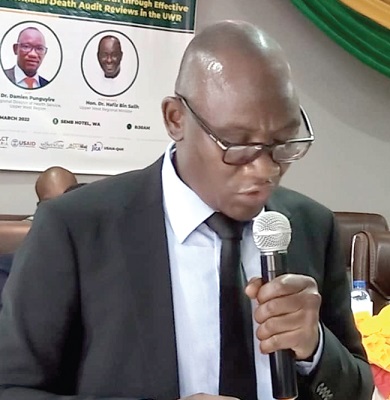
Maternal mortality: Silent killer in Upper West Region
The upsurge in maternal deaths due to complications associated with pregnancy and childbirth in the Upper West Region was the major concern for the stakeholders during the 2021 annual health sector performance review conference at Wa last Wednesday.
The two–day conference, which was also used to inaugurate the reconstituted regional health committee, was on the theme: “Improving maternal and perinatal health through effective maternal and perinatal death audit review in the region”.
Advertisement
Opening the ceremony, the Regional Director of Health Services (RDHS), Dr Damien Punguyire, lamented the high rate of maternal deaths and called for concerted efforts at all levels to reduce and improve women’s health in the region.
He said that during the year under review, there had been 28 maternal deaths recorded, rising from 22 deaths in the previous year, 18 in 2019, 22 in 2018, 26 in 2017 and 25 in 2016.
Late reporting
Dr Punguyire’s main worry was that majority of those deaths could have been prevented with timely medical treatment, citing delay in reporting as a pertinent factor contributing to the maternal deaths.
Apart from this, he noted, was against the huge investment made by government to improve the quality of care for maternal and new-born babies over the years.
These investments, the RDHS said, included life-saving skills training conducted for midwives, establishment of quality improvement teams, periodic forums for midwives, established and equipped new-born intensive care unit, among others.
He said the neonatal deaths had reduced drastically, adding that, the decline in neonatal deaths did not commensurate with the level of investment in maternal and perinatal deaths in the region.
“The audit process provides the opportunity to learn from critical events in the management of pregnant women and neonates. Health workers are given feedback to change from the practices that led to these events and also build capacity”, he said.
Doctors
He was happy to announce the return of 12 young doctors who had returned after gaining specialised skills after further studies, adding that the region had to be zoned into three to make utmost use of their skills.
Dr Punguyire said the region had also employed and deployed 933 staff of various categories but still lacked some critical staff coupled with lack of accommodation facilities in some districts.
He also highlighted on the low numbers of medical doctors in the region, which stood at a ratio of 1:12,500 with some hospitals manned by a single doctor.
“The entire population of Wa East is without a doctor,” he said.
COVID-19 pandemic
On the COVID-19 pandemic, he said since February 21, 2022, the region recorded 779 cases with 36 deaths constituting a case fatality of five per cent, which was higher than that of the national average.
He said the regional health directorate was taking steps to avert the lengthy period of getting results by installing six geneXpert machines in six district hospitals for laboratory confirmation of cases and another machine at the regional referral hospital to address the initial delays and huge cost in transporting samples to Tamale with its associated anxiety among patients and clinicians who had to wait for weeks to get laboratory feedback.
On vaccination, he noted that a total of 283,782 of the regional population, constituting 51 per cent, had received their first doses with 26 per cent of the population fully vaccinated and 2.7 per cent taking a booster dose.
He said they were now in the Cerebrospinal Meningitis (CSM) season, having recorded a total of 233 cases with three deaths last year, an improvement over the previous year record of 421 cases with 56 deaths. He said one of the major challenges had been the floods that led to the cutting away of six districts from the regional capital, Wa.
He was grateful to UNICEF for the immense support in various forms including capacity building.
Mortality
`In a speech read on his behalf, the Director-General of the GHS, Dr Patrick Kuma-Aboagye, bemoaned the increase in the institutional maternal mortality ratio from 106 in 2020 to 112 per 100,000 live births in 2021.
He further observed that institutional infant mortality rate also went up from 7.6 per cent to 7.9 per cent and that of children under five years from 9.6 per cent to 10.1 per cent from 2020 to 2021, respectively.
Dr Kuma-Aboagye, therefore, expressed satisfaction that the theme was appropriately chosen to address the issues.
The Regional Minister, Dr Haliz Bin Salih, felt that no woman should die during child birth, pointing out that abortion was one of the reasons for maternal deaths since a lot of single mothers and young women were using inappropriate means to redress their predicaments.
He said although abortion was legal in some instances, he called on the GHS to make it open to avoid such deaths.
The minister said government, in its commitment to improve healthcare delivery in the region, had earmarked five hospitals under the Agenda 111, some of which were under construction.



